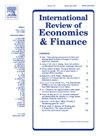The monetary aspects of the Dutch disease
IF 5.6
2区 经济学
Q1 BUSINESS, FINANCE
引用次数: 0
Abstract
This article examines two facts of resource-rich developing economies during resource booms: (i) appreciation and depreciation of the real exchange rate (RER), and (ii) central bank monetisation of fiscal deficits. Our monetary model demonstrates that changes in bank loans, domestic public debt, and monetisation account for RER dynamics, not resource rents. Resource rents finance two deficits: (i) the fiscal deficit, raising domestic prices, and (ii) the non-resource current account deficit, increasing supply through imports and lowering domestic prices, which offset each other with a net-zero effect on the RER. In contrast, Dutch disease models assume resource rents are spent on non-tradables instead of imports. The case of Trinidad and Tobago (1979-2022) supports the model’s prediction: monetisation, not oil rents, drives the RER. Empirical studies must control for the non-resource current account deficit and money-financed fiscal expenditures. Finally, the non-resource primary fiscal deficit must not exceed foreign borrowing and resource-based funding.
荷兰病的货币方面
本文考察了资源丰富的发展中经济体在资源繁荣时期的两个事实:(i)实际汇率(RER)的升值和贬值,以及(ii)中央银行财政赤字货币化。我们的货币模型表明,银行贷款、国内公共债务和货币化的变化是RER动态的原因,而不是资源租金。资源租金为两种赤字提供资金:(i)财政赤字,提高国内价格;(ii)非资源经常账户赤字,通过进口增加供应,降低国内价格,两者相互抵消,对RER的净影响为零。相比之下,荷兰疾病模型假定资源租金花在了非贸易品上,而不是进口上。特立尼达和多巴哥(1979-2022)的例子支持了该模型的预测:货币化,而不是石油租金,推动了RER。实证研究必须控制非资源性经常项目赤字和货币融资性财政支出。最后,非资源性初级财政赤字不得超过对外借款和资源性融资。
本文章由计算机程序翻译,如有差异,请以英文原文为准。
求助全文
约1分钟内获得全文
求助全文
来源期刊
CiteScore
7.30
自引率
2.20%
发文量
253
期刊介绍:
The International Review of Economics & Finance (IREF) is a scholarly journal devoted to the publication of high quality theoretical and empirical articles in all areas of international economics, macroeconomics and financial economics. Contributions that facilitate the communications between the real and the financial sectors of the economy are of particular interest.

 求助内容:
求助内容: 应助结果提醒方式:
应助结果提醒方式:


